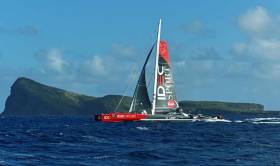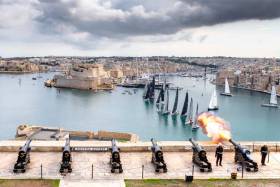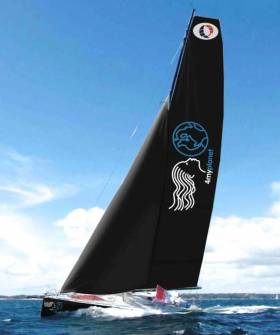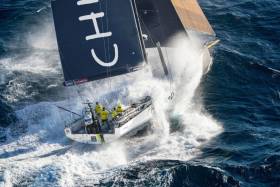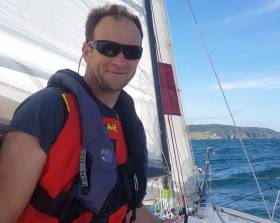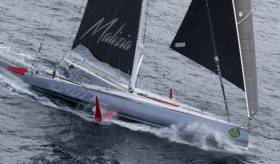Displaying items by tag: Offshore
Francis Joyon Smashes Mauritius Route Record on Giant Trimaran
The skipper of the IDEC SPORT maxi-trimaran shattered the Mauritius offshore Route record between Port Louis (Brittany) and Port Louis (Mauritius) at 0726hrs local time (0326hrs UTC) on Friday 8th November).
Francis Joyon smashed the reference time he set in November 2009 by more than six days and brings the Mauritius Route record down to less than 20 days or to be more precise to 19 days, 18 hours, 14 mins and 45 seconds.
The Mauritius Route record is the first act in the new campaign of ocean records, the IDEC SPORT ASIAN TOUR, which the skipper of the IDEC SPORT maxi-trimaran is currently tackling.
Brest Atlantiques Race for Ultim Class Begins in Strong Winds
The Brest Atlantiques offshore race officially started today, Tuesday 5th November, at 11 am, in front of the Chaussée de Sein in Brest, western France. The four trimarans of the Ultim 32/23 class set off at more than 30 knots of speed, with a north-westerly wind of about thirty knots and in a heavy sea with waves 4.5 metres high.
Trimaran Macif (François Gabart / Gwénolé Gahinet) was the first to cross the line, and shifted slightly northwards ahead of the three other competitors: Actual Leader (Yves Le Blevec / Alex Pella), Maxi Edmond de Rothschild (Franck Cammas / Charles Caudrelier) and Sodebo Ultim 3 (Thomas Coville / Jean-Luc Nélias), who were all at the southern end of the 2.5-mile line. On the first day out at sea, the descent down into the Bay of Biscay was fast, with heavy waves which should however gradually die down. They should cross Cape Finisterre, at the north-western tip of Spain, after about ten hours.
 The Brest Atlantique course
The Brest Atlantique course
QUOTES – The final words from the sailors before leaving the dock in Brest early this morning:
François Gabart (Trimaran Macif): "We're going to have to be careful in the Bay of Biscay with some tough conditions, but it's good to reach the trade wind quickly. We have to find the right pace from the start for the boat and for us. During the first few hours, we will always have one of us listening and not far from the helm to try to go fast without forcing the boat. A priori, there will not be many manoeuvres, it will be mostly piloting. »
Thomas Coville (Sodebo Ultim 3): "The first day in the Bay of Biscay will be very busy, you have to be very concentrated straight away; there can be no mistakes, it will take a lot of energy from the start. I can see what is at stake in these first few hours of racing, it's not insignificant, but I don't have any particular worries. We have to pass this Bay of Biscay fairly quickly, after that it's going to be an absolutely fabulous ride to Brazil. »
Franck Cammas (Maxi Edmond de Rothschild): "The start will be windy and tonight it will calm down, so we’ll go fast tonight! Until then, we'll try to be careful, to get out unharmed in Cape Finisterre, there's no point in attacking from the start, we're only at the beginning of the race. We can do more tomorrow morning when we're already south enough! »
Yves Le Blevec (Actual Leader): "The start days are always important moments, we are feeling confident, it's finally time to sail! The first ten hours will be cautious, it will be necessary to balance the need for speed and competition with that of being safe.
Irish Input for Lucky’s New Hong Kong-Vietnam Offshore Race Record
American Bryon Ehrhart’s impressive Maxi 72 Lucky has added a new gong to her distinguished trophy list by taking line honours and establishing a new course record in the biennial Hong Kong to Vietnam Offshore Race, aided in no small measure by an experienced Irish presence in the crew.
Rockstar navigator Ian Moore of Carrickfergus - who piloted Ehrhart’s previous 63ft Lucky to a stunning win in the 2017 Transatlantic Race – was calling the shots, also aboard was ireland’s David Parker, while very much in evidence was the hugely-experienced Shane Diviney of Howth, who posted this brief vid of the hosing experience which is needed for record-breaking in the 673 mile dash to Vietnam. At least the water is warm…
40th Middle Sea Race Underway
The 2019 Rolex Middle Sea Race, the 40th edition of the 606nm classic offshore, set off from Grand Harbour today with Irish crews among its number.
A fleet of 113 yachts, separated into seven starts, were wafted on their way by a very gentle northerly breeze that sent cat’s paws across the harbour, and left plenty of traps for the unsuspecting. No matter, for the competitors – both professional and Corinthian – the start is just the beginning of a challenge that is not meant to be easy.
By 17:00 CEST, the fleet was making slow progress en route towards Capo Passero and the southernmost point of Sicily. On the water, Italian trimaran, Ad Maiora has a slim lead over the leading monohull, Rambler (USA), with the 34-foot catamaran Blackwater (AUS) just behind. Yachts are hugging the rhumb-line and the wind is a light southwesterly of around 8 knots.
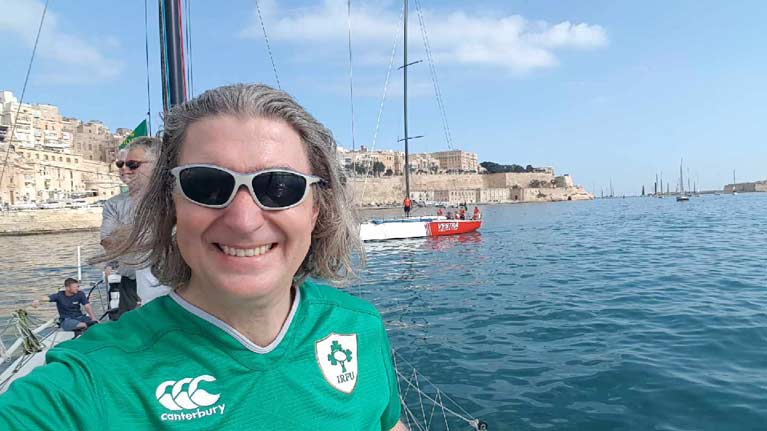 The National Yacht Club sailor William Despard on the deck of Andrew Hall's Jackhammer from Pwllheli before the start of the Middle Sea Race
The National Yacht Club sailor William Despard on the deck of Andrew Hall's Jackhammer from Pwllheli before the start of the Middle Sea Race
Grand Harbour, Valletta, is a majestic environment on any day. For the start of an offshore race it is exceptional. Overlooked by the fortified city of Valletta, to the west, and The Three Cities, to the east, with a narrow exit through the breakwaters, it is a rare sight filled with yachts. Thousands of well-wishers gathered on the shoreline and on the water add to the festive air.
With very little wind to speak of at 11:00 CEST, when the first warning signal was fired by the cannons of the Saluting Battery, there was some concern that the multihulls would struggle to get away, when their class gun was due 10 minutes later. As it was, the best starts were achieved by the four-man crew of the tiny Blackwater, skippered by Christiaan Durrant, and the more luxuriously appointed Apollo (GBR), skippered by Nigel Passmore. Bruno Cardile and the ORMA 60, Ad Maiora, took their time to wind up and cross the line. Once in motion, they quickly overhauled the two early leaders and were first out of the harbour, followed by Blackwater. Meanwhile, the Outremer 55, Asia (ITA), was having a nightmare, struggling to get across the line and taking some 40 minutes to reach the breakwater. Given the slow progress, Peter Dimech and the Royal Malta Yacht Club Race Committee wisely delayed the next start.
Class 6, the biggest in the fleet with 27 boats, eventually set off 20 minutes later than scheduled. Comprising some of the smallest boats, and including a number of double-handers, it was congested and close fought. Exiting the harbour first has little impact on the overall race result, but it is a big fillip for the crew that achieves the feat. The Sun Fast 3600 Bellino (GBR) absolutely nailed the start and the crew kept their wits to win this first battle. Behind, Timofey Zhbankov’s JPK 10.80 Rossko (RUS), winners of IRC 6 in 2018, JYS Jan (MLT), the all-female-crewed J/109 skippered by Gabriella Mifsud with Clipper Race star Nikki Henderson, and Gerard Ludovic’s JPK 10.80 Solenn (FRA), second in IRC 6 last year, were line abreast having worked their way clear of the pack.
There were 21 yachts on the line in Class 5. Given this group contained the 2018 Rolex Middle Sea Race winner, Géry Trentesaux’s JPK 11.80 Courrier Recommandé (FRA) and the JPK 11.80 Sunrise (GBR) with John Jr and Tom Ripard in the crew, it was a surprise to see Andrey Arbuzov’s Beneteau 44.7 Courrier de Coeur (RUS) making the running with the J/111 Blur (SWE) and the Comet 41S O’Guerriero (ITA) in hot pursuit. Despite the wind resisting the temptation to fill in, there was enough to keep the boats moving if their crews kept a close eye on the puffs.
The Podesta family’s First 45 Elusive 2 (MLT) made a strong start in middle of the 24 boat Class 4, but was quickly overhauled by Philippe Frantz’s NM43 Albator (FRA), and Laurentiu Gaitan’s X-Treme 37 Africana (ROU). BeWild (ITA), the ClubSwan 42 also made the best of the shimmering breeze and was among the front-runners. The Timmy Camilleri/Richard Schultheis co-skippered Xp44 Xp-act (MLT) seemed to make hard work of the start and were trailing their sister ship Xtra Staerk (FIN) for much of the harbour beat. The combination of Camilleri’s experience and the 14-year-old Schultheis’ skill, was enough to get them out of the harbour eventually just behind BeWild and ahead of their direct competitors.
Prima Vista-Lauria (ITA), winner of the 2019 Rolex Middle Sea Coastal Race, continued to perform well, with a good start in the 14-boat Class 3. The Marten 49 Ginger (SUI) was close by, while Lee Satariano’s HH42 Artie III (MLT), with Christian Ripard on the helm, lifted off from the Fort St. Angelo (pin end) of the line with Frogfoot (RUS) in close company. Taking a rhumb-line route from the harbour, Frogfoot and Prima Vista-Lauria appeared to have the edge on Artie, which headed in to the Valletta shore much to the delight of the crowds in the Lower Barrakka Gardens, enjoying the hospitality of the Royal Malta Yacht Club’s reception. The two-time winning crew on the Maltese boat will not be too disturbed to have been behind at this point.
The 10-boat Class 2 featured a number of the big guns. Anxious to get a good start and a clean lane, the TP52 Anafesto (NED) appeared to jump the start early and had to return. This left Gerard Logel’s IRC 52 Arobas² (FRA) free to make good headway towards the harbour entrance. The crew of Stefan Jentzsch’s Carkeek 47 Black Pearl (GER) quietly went about their business, overhauled Arobas²2 and had established clear air between them and a chasing pack comprising Teasing Machine (FRA), Kuka 3 (SUI) and Riff Raff (GBR) on exiting Grand Harbour.
The final start at 12:30 CEST was reserved for the largest monohulls. The Rogers 82 Aegir (GBR), chartered by American Clarke Murphy with Ian Budgen on tactics and Mike Broughton navigating made a cracking start, and not for the first time at the Rolex Middle Sea Race. The RP60 Wild Joe (HUN), skippered by Marton Josza with ocean race veteran Stu Bannatyne in the crew and the smallest yacht in the group, also made an excellent fist of it, as did the Marten 72 Aragon, crewed by a group of Polish sailors led by Przemek Tarnacki, whose father Bronislaw Tarnacki took part in the very first Whitbread Race in 1973.
In what looked decidedly like the second row, the light airs were causing some consternation as the larger, ocean racers took their time to get up to speed. It took half the harbour for line honours favourite Rambler to assert her authority and escape the attentions of her smaller rivals. Telefonica Black had the honour of being last boat to leave Grand Harbour.
17:00 CEST Class Analysis Based on Tracker Positions
The light air conditions continued after the start with the fleet experiencing about 8 knots of gradient breeze from the southwest. George David's Maxi Rambler is leading the monohull fleet having covered 26 nm. A pack of five boats is four miles astern, Pendragon (HUN), Arobas², Wild Joe, Wizard (USA), and Aragon. In the MOCRA Class, Bruno Cardile's Ad Maiora has the honour of not only leading the multihull fleet, but is also two miles ahead of Rambler. The Dazcat 1495 Apollo looks to be leading the MOCRA Class after time correction.
The overall winner of the Rolex Middle Sea Race is decided by the best corrected time under the IRC Rating Rule. Renzo Grottesi's BeWild appears to be in pole position, with the ICE52 PrimaVista-Lauria skippered by Pietro D'Ali in second and Philippe Frantz's in third, just ahead of Courrier Recommandé.
IRC 1
Aragon leads Wild Joe with Fabio Cannavale's Baltic 78 Lupa of the Sea (ITA) in third.
IRC 2
Arobas² leads Black Pearl with Franco Niggeler's Cookson 50 Kuka 3 in third, just ahead of sistership, Brian McMaster's Riff Raff.
IRC 3
PrimaVista-Lauria leads from Artie III with Frederic Puzin's Corum – Daguet2 (FRA), with ocean racer Seb Josse aboard, in third.
IRC 4
BeWild leads from Albator and Arto Linnervuo's Xp 44 Xtra Staerk (FIN) in third
IRC 5
Courrier Recommandé leads Gianrocco Catalano's First 40 Mon Ile (ITA) with Peter Gustafsson's J/111 Blur in third
IRC 6
Igor Rytov's JPK 10.80 Bogatyr (RUS) leads from Leonardo Petti's J/109 Chestress (ITA) with JYS Jan in third.
IRC Double Handed
Bogatyr leads Marco Paolucci's Comet 45 Libertine (ITA) in second and Rob Craigie's Bellino (GBR) in third.
Solo sailor Joan Mulloy of Mayo has teamed up as co-skipper with France’s Alexia Barrier on the latter’s veteran IMOCA 60 4Myplanet to become the only all-female crew in the 30-strong IMOCA 60 Class in the 12,000 mile Transat Jacques Vabre, which starts next weekend from Le Havre, headed for a finish in Bahia in Brazil.
In all, there’ll be 67 boats on the line at Le Havre in three classes in an event which last month brought aboard an additional sponsorship partner in the Normandy Region. This reflects the increasingly positive corporate approach of French regional administrations to major sailing events, where the pace has been set by the Vendee Region with their pillar event, the four-yearly Vendee Globe non-stop solo round the world race, which has succeeded in raising the profile of the relatively little-known Vendee to a new international awareness.
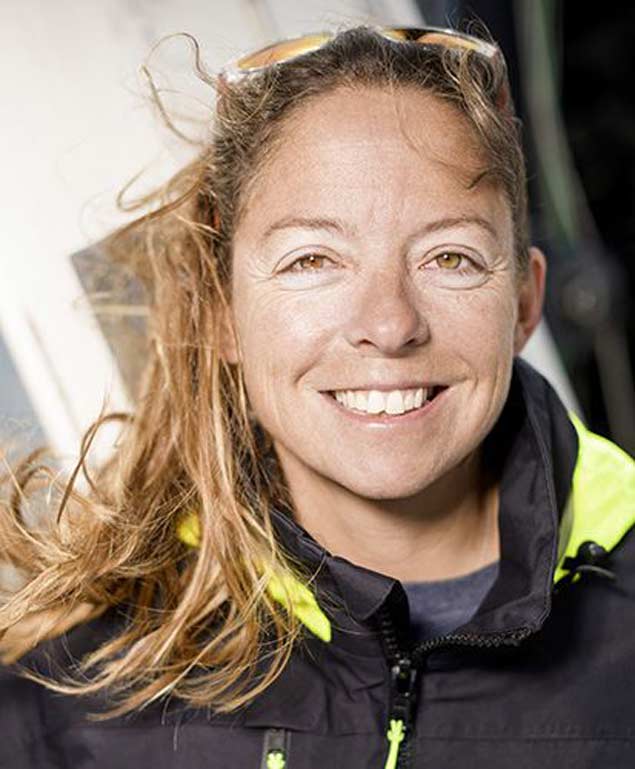 Alexia Barrier, tired but happy after completing another solo challenge. Her finish in last year’s Transatlantic Route de Rhum has already qualified her for next year’s Vendee Globe Solo
Alexia Barrier, tired but happy after completing another solo challenge. Her finish in last year’s Transatlantic Route de Rhum has already qualified her for next year’s Vendee Globe Solo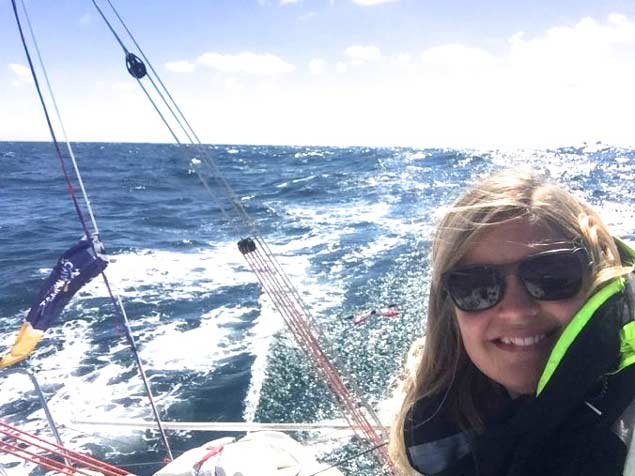 Joan Mulloy where she is happiest – in open water with the boat going well
Joan Mulloy where she is happiest – in open water with the boat going well
In France, the regions are in competition with each other and internationally to attract such events. The Port of Brest, in one example, has taken over the historic OSTAR. But in smaller countries, it’s a case of the entire nation wheeling in support, as is being seen this morning in Malta where a major offshore race – once of interest to only a select few on the island – is now high on the priority list of the government’s promotion department.
Today, in the almost absurdly picturesque and distinctly crowded history-laden Grand Harbour of Valetta in Malta, it will take seven different starts to get the total fleet of 112 boats in the 40th Edition of the 606-mile Rolex Middle Sea Race cleanly away. From this inevitably tense and crowded start to a multi-island-rounding course in the Mediterranean, they’ll have the finishers back in port and the results declared by the time the Transat Jacques Vabre comes top of the agenda on Sunday October 27th.
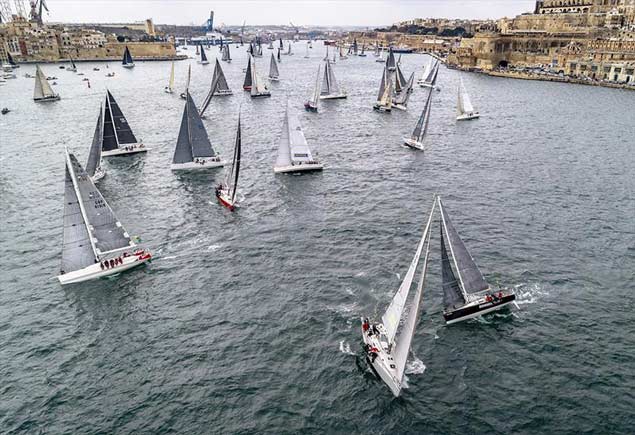 Classic start for a classic race – the Rolex Middle Sea race tacking out of Grand Harbour Valetta in close formation. Photo Rolex/Kurt Arrigo
Classic start for a classic race – the Rolex Middle Sea race tacking out of Grand Harbour Valetta in close formation. Photo Rolex/Kurt Arrigo
For devoted inshore sailing enthusiasts who think that night-time is when you should be comfortably ashore in bed after a good day’s sailing in pleasant coastal surroundings, both of these major international events are simply seen as being lumped under the general heading of “Offshore & Ocean Racing”. And their overall response is “Thanks but no thanks…..”
Yet for aficionados, not only are they long hauls which will be avidly followed throughout with total dedication, but the very different types of offshore racing which they exemplify are all part of the fascination.
For the Rolex Middle Sea Race is one contemporary version of the classic Royal Ocean Racing Club “long one”. These are the well-established events such as the Fastnet Race itself, the Sydney-Hobart, the RORC Caribbean 600 and the Newport-Bermuda, all of which fall within the 600-650 mile distance range. Also generally included is the Round Ireland, even though it clocks up 704 miles. And all – when they were founded – were regarded in their day as marathons, a title which most participants continue to happily support.
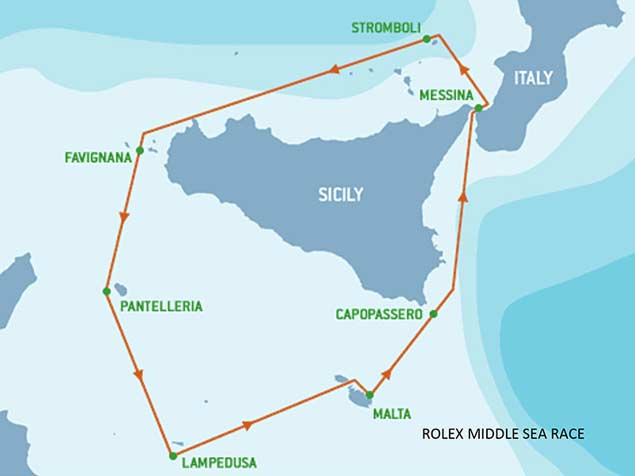 The Middle Sea Race course – anyone who thinks it’s a walk in the park is often brutally surprised
The Middle Sea Race course – anyone who thinks it’s a walk in the park is often brutally surprised
But with the international ocean racing bar now being set very high by the Vendee Globe with its off-the-wall IMOCA 60s, public perception may have become more muted in response to the more traditional events. Yet the fact that the biennial Fastnet Race’s basic entry limit for 350 boats is hit within minutes of the online acceptance opening for business tells us that the mystique of these classics is strong, and for recreational sailors of competitive offshore interest, they are very much something they want to have in their CV.
Because there’s a real continuity to these events - with a shared sponsor in Rolex - part of the interest is in discerning special patterns. So although George David’s great round Ireland record-holding Rambler 88 will be seeing can she better the Middle Sea Race’s 47 hours 55 minutes and 3 seconds record he set with Rambler 90 in 2007 (a decidedly tense-making four minutes and 57 seconds inside the magic 48-hours barrier), there’ll be every bit as much interest in how things go for Wizard, the Askew brothers’ former Volvo 70 from America.
Originally Groupama 4 and designed by Juan Kouyoumdjian for the 2011-12 Volvo Ocean Race - which she won for France skippered by Franck Cammas - this splendid “old” warhorse has by no means gone gently into the sweet night of retirement.
On the contrary, she reappeared under New Zealand ownership for the 2016 Rolex Sydney Hobart re-named Giacomo, owned and skippered by wine magnate Jim Delegat, who had several of his family in the crew, including the youngest race participant, 18-year-old James Delegat Jnr, as Australian rules preclude anyone under 18 doing this race. Conditions suited a Volvo 70 almost to perfection and they managed second on line honours among much larger craft, and this in time converted into the overall win.
Thus Giacomo was arguably the first of the former Volvo 70s – they initially appeared in 2005 - to make a significant input outside the Volvo Ocean Race bubble. But the former Groupama 4 was only getting going. Having won outright in what was only his third Sydney-Hobart, Jim Delegat decided to get out while still on top, and soon he sold Giacomo on to Peter and Dave Askew from America, who lavished much TLC on a craft renamed again. She became Wizard, and she lived up to her new name from the get go.
 The former Volvo 70 Wizard making knots. One of the world’s most successful offshore racers, since 2012 under three different names she has won the Volvo Ocean Race, the Sydney-Hobart, the RORC Caribbean 600, the Transatlantic, and the Fastnet. Photo: Rolex
The former Volvo 70 Wizard making knots. One of the world’s most successful offshore racers, since 2012 under three different names she has won the Volvo Ocean Race, the Sydney-Hobart, the RORC Caribbean 600, the Transatlantic, and the Fastnet. Photo: Rolex
Skippered for the brothers by Charlie Enright, Wizard has continued as a real life-enhancer on the international offshore scene, and with the Volvo Ocean Race and the Rolex Sydney-Hobart trophies already in the collection, she hit the 2019 programme in style, taking line honours in February’s big-fleet RORC Caribbean 600, and then correcting into the overall win.
Next outing was the RORC/NYYC Transatlantic Race with the weather in the North Atlantic in an increasingly obtuse mood, with calms later plaguing the smaller boats. But it was by no means a cakewalk for the biggies either, yet Wizard called it just right, and took the overall win.
Then up came the Rolex RORC Fastnet Race on 3rd August 2019, and in the livestream at the start, as the camera panned past Wizard somebody in the commentary box let slip a remark to the effect that this was “an old Volvo 70, not really suited to this race”, or words to that effect.
 Having made a brilliant job of the tricky outward stages to reach the Fastnet Rock, Wizard did even better on he final stage to Plymouth to win overall. Photo: RolexNow that was some hostage to fortune….not only did Wizard make such a perfect job of getting through the sticky calm-plagued patch between Start Point and the Lizard that we assumed the great Ian Moore must be the navigator on board (he wasn’t), but then when Wizard’s group arrived at the Fastnet itself, a complex frontal system was going through to baffle many. Yet Charlie Enright called the sail changes to precise perfection, they piled on the miles to a challenging position, and swept into Plymouth to correct into such a strong time that soon Wizard was declared the overall winner.
Having made a brilliant job of the tricky outward stages to reach the Fastnet Rock, Wizard did even better on he final stage to Plymouth to win overall. Photo: RolexNow that was some hostage to fortune….not only did Wizard make such a perfect job of getting through the sticky calm-plagued patch between Start Point and the Lizard that we assumed the great Ian Moore must be the navigator on board (he wasn’t), but then when Wizard’s group arrived at the Fastnet itself, a complex frontal system was going through to baffle many. Yet Charlie Enright called the sail changes to precise perfection, they piled on the miles to a challenging position, and swept into Plymouth to correct into such a strong time that soon Wizard was declared the overall winner.
 Charlie Enright of Wizard, a skipper of genius
Charlie Enright of Wizard, a skipper of genius Sporting owners – David and Peter Askew in Antigua, February 2019, after Wizard had been declared overall winner of the RORC Caribbbean 600
Sporting owners – David and Peter Askew in Antigua, February 2019, after Wizard had been declared overall winner of the RORC Caribbbean 600
By this time Wizard was so cheerfully the ambassador for American offshore racing that it was natural to overlook the fact that her take-everything victory was in fact yet another corner-stone in the French domination of the Rolex Fastnet Race 2019. But while she may have been French in her origins, it’s only right and proper to credit that David & Peter Askew and Charlie Enright, plus Jim Delegat before them, have put their stamp firmly on a record of unrivalled and varied success which extends directly back to Franck Cammas in 2012.
So with the Volvo Ocean, Sydney-Hobart, RORC Caribbean 600, Transatlantic 2019 and Fastnet Race securely under her belt, Magic is surely the boat to watch as the fleet set about exiting Grand Harbour Valetta this morning for a challenge whose name suggests balmy Mediterranean sailing, yet experience has shown that the Middle Sea Race in October plumb in the midst of Mare Nostrum can be tough and then some.
 Ireland’s Barry Hurley will be racing a Dazcat 195 catamaran in the Middle Sea Race today – this is how she looks in steady going……..
Ireland’s Barry Hurley will be racing a Dazcat 195 catamaran in the Middle Sea Race today – this is how she looks in steady going……..
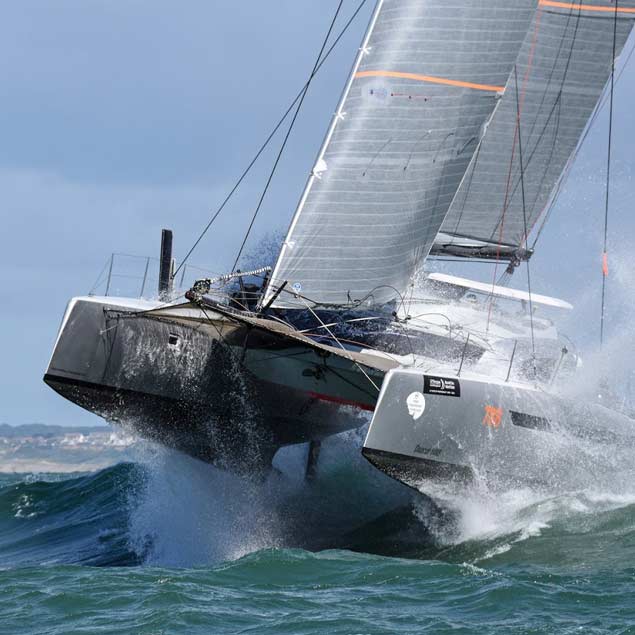 ……and this is the Dazcat 1495 in a bit of a breeze
……and this is the Dazcat 1495 in a bit of a breeze
Ireland’s most experienced participants in it is Barry Hurley, with something like 14 tilts already logged for this circuit of islands which include - for something a little different - the active volcano of Stromboli. Former OSTAR Class winner Hurley has been well in the frame in mono-hulls in the Middle Sea Race several times, but this year he’s trying a new approach in a multi-hull, in this case the DazCat 1495 Apollo.
It requires very special skills and nerves of steel to race a catamaran flat out along a course which takes in coasting along steep mountains and through areas notorious for sudden squalls, but if the chips fall the right way the rewards are immense.
A more orthodox entry with Irish interest is ISORA Pwllheli-based skipper Andrew Hall with his J/121 JackHammer, a much roomier proposition than the vintage ultra-slim J/125 JackKnife which he raced – usually in the frame - in the Irish Sea during the 2019 season.
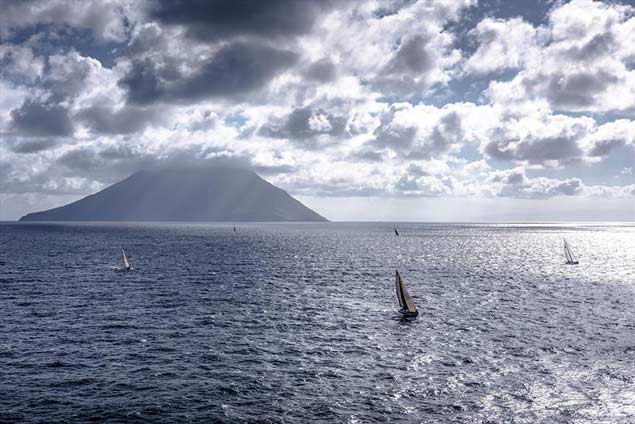 How’s this four a mark of the course? There’s no guarantee that the Stromboli volcano won’t be erupting as the Middle Sea Race fleet rounds it. Photo: Rolex
How’s this four a mark of the course? There’s no guarantee that the Stromboli volcano won’t be erupting as the Middle Sea Race fleet rounds it. Photo: Rolex
His crew includes NYC sailor Willie Despard, so we have direct interest in at least two boats, and doubtless, other Irish participants will emerge as this intriguing race progresses. But anyone with an interest in the general wellbeing of world offshore racing cannot help but feel involved in the continuing extraordinary progress of Wizard. This is one well-sailed and classy boat which has given many people an immense amount of sporting satisfaction, and though it's grossly unfair to be heaping so much expectation on her prospects in the Middle Sea Race, but that’s the way it is. And we can be consoled by her string of established successes if things don’t work out to perfection this time round in a complex race in which the defending champion is France’s very special Gery Trentesaux in his JPK 11.80 Courier Recommande.
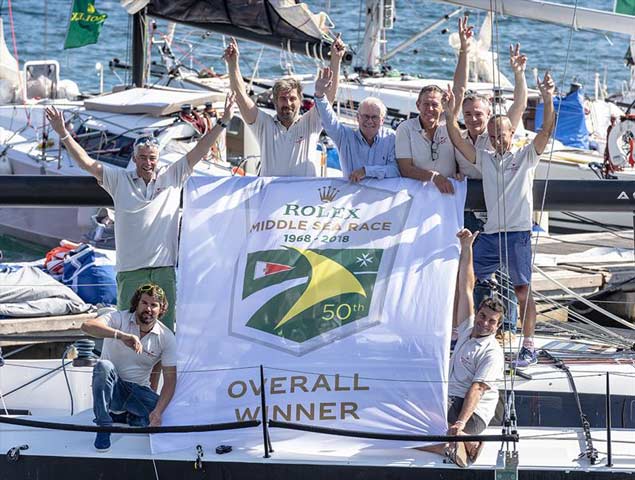 Defending champion: France’s veteran superstar Gery Trentesaux (centre) is defending title-holder in today’s Middle Sea Race
Defending champion: France’s veteran superstar Gery Trentesaux (centre) is defending title-holder in today’s Middle Sea Race
As to how things will be shaping up in a week’s time in the final countdown to the Jacques Vabre start off Le Havre, Alexia Barrier and Joan Mulloy don’t pretend that their 1998-built oldie 4myplanet – a pioneering Marc Lombard design in her day - is anything other than a sporting entry when set against the likes of Alex Thomson and Neal McDonald in the former’s latest addition to the Huge Boss line, and much is also expected of other fresh-out of-the-wrappings IMOCA 60s like Clarice Cremer and Armel le Cleach in Banque Populaire.
After all, with the basic budget of €5 million which created the new Hugo Boss, you could buy a dozen vintage IMOCA 60s…….
 The latest – Banque Populaire X continues a long line of financial services sponsorship in French ocean racing
The latest – Banque Populaire X continues a long line of financial services sponsorship in French ocean racing 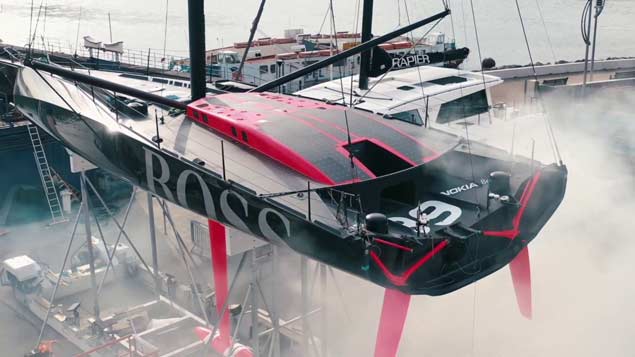 Ultimate racing machine? The new Hugo Boss will be using the Transat Jacques Vabre 2019 as a debut event.
Ultimate racing machine? The new Hugo Boss will be using the Transat Jacques Vabre 2019 as a debut event.
The sixth edition of the RORC Transatlantic Race is set to feature a huge variety of yachts racing across the Atlantic Ocean with the Royal Ocean Racing Club. One-design VO65s and Maxi yachts have expressed their goal to take line honours and a tilt at the race record. Teams racing optimised performance cruisers will be aiming for class and the overall win under the IRC Rating Rule. Two-Handed teams will add a fascinating dimension to this bucket-list race.
The Wally 100 Dark Shadow is the largest yacht on the entry list and although the 100ft Frers-designed carbon-fibre Maxi has close to 5,000 sq. ft. of sail area, she faces fierce competition for line honours. Dark Shadow's Race Skipper will be Australian Yerin Hobson and the international crew have sailed for the owner in over 30 races, including two previous Transatlantic Races. The team's first objective is to beat their own transatlantic race record of 11 days, 21 hours, 33 minutes.
Several Maxi yachts have expressed their interest to race as well as a number of One-design VO65s, including the Austrian Ocean Racing Project, a young team skippered by Konstantin Kobale. The VO65 Childhood 1 will be skippered by Dutch legend Bouwe Bekking who has sailed in eight round the world races in a career stretching back to 1985. In the last four editions of the Volvo Ocean Race, teams with Bekking as skipper have been on the podium three times. The race record of 10 days 5 hrs 47 mins 11 secs (2018 Pier Luigi Loro Piana's Supermaxi My Song) is under threat from these ocean greyhounds.
One of the smallest entries will be competing in the IRC Two-Handed Class. Richard Palmer's British JPK 10.10 Jangada returns for their second RORC Transatlantic Race after winning IRC 2 and IRC Two-Handed in 2017. Palmer will be racing with his long-time team-mate, Jeremy Waitt.
The RORC Transatlantic Race is unfinished business for Giles Redpath's British Lombard 46 Pata Negra which has the National Yacht Club's Conor Totterdell onboard. Totterdell is racing with a small crew of 6, including Figaro Sailor Will Harris.
In 2016 Pata Negra retired after damage to the starboard rudder. Since then Pata Negra has won the Sevenstar Round Britain & Ireland Race and the Antigua Bermuda Race, and must be considered as one of the favourites for the 2019 RORC Transatlantic Race. Also returning is Benedikt Clauberg's First 47.7 Kali, owned by the Swiss Ocean Racing Club, and making their debut in the race will be the overall winner of the 2019 La Trinite Cowes Race, Jean Pierre Dreau's French Mylius 60 Lady First 3.
Entry is still open for the 2019 RORC Transatlantic Race and several teams have charter berths available to aspiring transatlantic racers. The 6th edition of the RORC Transatlantic Race will start from Marina Lanzarote on 23 November 2019. -- Louay Habib
#Rowing: Ireland will send a big team to the World Coastal Rowing Championships in Hong Kong early next month (November 1st to 3rd). Coastal Rowing is growing and may become part of the Olympic programme.
Niall O’Toole (49) was Ireland’s first world rowing champion. The three-time Olympian now runs Crew Class for indoor rowers. He tried his luck at the Irish Offshore Rowing Championships in September in Co Antrim. Here are his impressions.
The Rock’n Roll of Offshore Rowing
By Niall O’Toole
I was excited for my first offshore race. Rounding the corner, I arrived at the location to big breaking waves crashing onto the shoreline. I immediately knew this was something different: it was going to be ugly and unpredictable.
I fully hoped that the regatta would be called off, due to the extreme weather conditions. I looked to other competitors for solace. Instead of being able to gauge their fear, I was met with wide grins and a crazy glint in their eyes: they were unfazed. This was their normal. They were just looking forward to getting amongst it.
I’m used to something different. A sterile environment in your own lane, as fast as you can row from A to B over 2km. You train for your own race, your pace and pushes planned down to a T. You have very little to think about on the day, other than executing that race plan. A starter holds your stern, everyone in line, traffic lights signal the off. It’s all inch-perfect and highly controlled. You may have one or two glances out of the boat, but essentially you row without interference from others.
In Olympic-style rowing, we are guarded from the elements. Most international courses are strategically located to have a prevailing wind in one direction to avoid rough water. If there is wind, the water tends not to be affected. I wasn’t used to nature writing the rules.
There was a delay to racing due to a late change of course. We were told that it was no longer safe for the safety boats, and that rowers were likely to be pushed onto the rocks. When the officials said, “You need to ask yourself, is it safe for you to row today?” the answer was screaming in my head. The organisers said they’d run the first race and would review whether they would continue the regatta after that. I took this to mean that the first race competitors were now officially the canaries down the mine. They got around, despite buoys moving during the race, and the regatta continued, to my growing fear and dismay.
Shouldered with the weight of some rowing heritage behind me, I had to harness my dwindling toughness and get out onto the water, launching amidst breaking waves on the beach. Within 30 seconds I was completely soaked and instantly thought we needed a bigger boat.
The race starts with a floating start and is the only real part that you can plan. There are no individual lanes, just a fight for the best line around a 4km course of buoys. Your only real hope is to fly out the start and get clear of the field down to that all important first buoy, before traffic starts hitting you and rowing becomes a contact sport.
Battling the elements, and trying to keep the boat straight without a tiller was absolutely exhausting. Given my experience, I went out high and hard, but found it difficult to factor in the added dimensions of staying away from other boats and staying on the right lines to hit the markers. Trying to keep the boat straight against a crushing side-wind completely seized up my forearm within minutes of the start. Within the washing machine of the wind and waves, and the physical exertion of breathing through your ears, you are punished for small navigational mistakes which are big errors, handing away hard-fought lengths to more savvy and seasoned competitors.
I did enjoy it though, despite myself. The rush of adrenaline you get flying around buoys, fighting for your line, with other boats breathing down your neck. You are completely focused on getting in and out of the turn as quickly as possible, whilst also paranoid that your competitor is taking a better line, for reasons as yet unknown to you. The sheer volume of data you have to integrate along with the physical exertion maxed me out in a way I couldn’t have imagined.
This is one hell of a sport. Chaotic, unpredictable and exhilarating. It really is the rock’n roll of rowing. I’m completely hooked.
Niall O’Toole was part of the winning men’s quadruple, a composite crew of Wicklow, Kilurin and Ring, at the Irish Offshore Championships.
Offshore Sailing Top Tips from Yannick Lemonnier of UK Sailmakers Ireland
Although the offshore sailing season is drawing to an end; it is never too early to look to your 2020 sailing season. Offshore racing, both crewed and shorthanded, is one of the biggest growth areas of sailing domestically and internationally.
UK Sailmaker's Yannick Lemonnier is one of the most experienced offshore racers in the country. With over 10 years of experience and more than 80,000 miles under his belt, mostly solo and double-handed, he is full of offshore sailing knowledge. Here gives us some top tips to bring into your 2020 offshore sailing season.
The Mainsail
The main is the one sail that we always have up, no matter the point of sail. Trimming and managing it is crucial to success – so how can you make life a bit easier?
 A reefed mainsail
A reefed mainsail
- Stitch all your battens. This is as simple as using a hand sewing needle to put a quick stitch at the extremity of each batten pocket. This fully secures your battens no matter what weather you encounter. The consequences of losing battens can be dramatic for the integrity of the sail and its performance.
- Reefing. Tie the bottom part of your mainsail with small diameter bungee and plastic clips instead of solid rope. Releasing your reef with one tie remaining can seriously damage your sail – and can easily happen when tired or on a dark night.
- Glow-in-the-dark draft stripes. These make trimming your sails at night so easy. Each stripe should be marked at the 50% chord length to give a good shape reference. These stripes can be retrofitted to older sails (depending on their age).
- Reef assistant. This is a great option for regular offshore racers. Basically it is an additional pennant set just above your reefing eye at the luff end of your mainsail. It gives you a solid anchor to either pull your reef towards its hook or release pressure to unhook the reef in strong winds.
- Tie up the sail, not the boom! This is one we see a lot. When lashing up your reefed sail to not tie it around the boom. Instead, lash it around itself. You should have a tie going from the leeward side, around the loose sail between itself and the boom, and tied securely on the windward side with an easy to release knot.
 Glow in the dark sails
Glow in the dark sails
 A reefed mainsail tied
A reefed mainsail tied
Headsails
When sailing upwind or tight reaching, depending on your inventory, you will be using your headsails – quite likely multiple headsails. Keeping on top of them and practising crew manoeuvres with them is critical to a successful offshore race.
- Stitch all your battens. This is the same as with your mainsail – but even more so as your headsails are more exposed to flapping as they are hoisted and dropped. Securing the battens is essential. This is a really quick and basic job which can prevent a lot of trouble down the line.
- Peels and tack peels. This manoeuvre is a must – and it is not complicated with proper training and the correct setup. Having a second attachment either side of the tack attachment point is recommended. And make sure to keep a close eye on your halyard to ensure no wraps occur. I would recommend to always drop the sail on the inside as dropping outside is risky and can lead to you losing your sail!
- Glow-in-the-dark draft stripes. As with the mainsail, these make setting halyard tension, car positions, sheet tension etc much more efficient at night. Glow tell tails on the luff make steering and trimming a doddle on those dark nights.
- Spare sheet and block. This is to clip onto the outside rail, or purpose installed padeye, to outhaul the headsail on a reach. This is essential. Every time your clew moves up and down you are losing power. A well-positioned outboard lead padeye and the hardware to go with it makes a huge difference to off the breeze speed.
- Know your inventory. Knowing your sails is critical regarding wind range and angles. Where is your limit between J2 and J3? Between an outhauled genoa and code zero? The only answer is practice and recording. Experiment with different setups and take note of what works, and more importantly, what doesn’t!
 Outboard lead
Outboard lead
Spinnakers
We all love sailing downwind when offshore. It can be fast and fun. It can certainly be a lot more comfortable than beating into a gale! But it brings its own challenges.
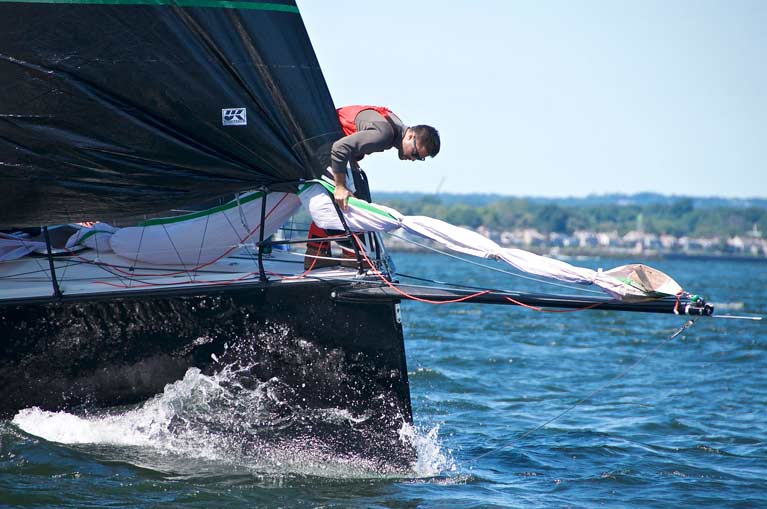 Spinnaker stops on sail tack
Spinnaker stops on sail tack
- Choose your colour carefully. White spinnakers are difficult to trim at night. They are like a ghost. I would recommend a dark colour to get more contrast – I also find white harder on your eyes in bright sunshine.
- Velcro for control. Heavy spinnakers should be equipped with Velcro banding to keep them deflated while hoisting. They allow you to hoist the sail and stabilize the boat, then pop the sail out when everything is ready.
- Repair early. Gets lots of 100mm insignia tape (stick-back dacron) to fix small tears that can become a bigger problem. This tape can also fix other sails along with a bottle of acetone (nail varnish remover) to remove salt and dry the sail surface.
- Inspect for chafe. Don’t worry, we’re talking about your halyards! If on a long spinnaker run chafe can become a real issue. Covers can wear on sheaves or deflectors overnight. Ease the halyard a foot and check with the binoculars for visible signs of damage. If you can see it with binoculars it will be a bigger problem sooner rather than later.
- Peeling practice. Peeling spinnakers is actually easier than peeling headsails. The most crucial element is good halyard management. Have a spare peeling sheet, with snap shackle, ready and accessible. Think and talk the manoeuvre through – and, as always, practice!
Storm Sails
Whether we like to admit it or not, there is a tendency to see storm sails as a box-ticking exercise. Not many sailors have a clue how to rig them, never mind use them properly!
 Storm sails
Storm sails
- Firstly they should be stored in a separate dry bag. Piston hanks tend to corrode in an offshore environment unless used regularly – they should be replaced with soft shackles.
- The storm jib should have a tack strop of a set length. This should position the sail at a height that lines the clew up nicely with your jib car position.
- The trysail should ideally be on a separate track. It should be rigged with spinnaker sheets lead inside the guard rails – as we discovered after training in just under 50 knots!
Summary
A huge part of offshore racing is managing your energy. By making the boat as easy to sail as possible, and removing any potential issues before they occur, you can put 100% of your energy into making the boat go fast. Plan, practice, and enjoy your offshore adventures
Malizia II’s Atlantic Challenge Knocked off Course by Crew Injury
This week’s attempt by the Monaco-based Malizia II to set up a Transatlantic west-east record time for a fully-crewed IMOCA 60 with two Irish – Shane Diviney and Brian Carlin – in the crew of five, has been knocked off course by a crew injury which has necessitated a diversion on Day Three for medical assistance at St Pierre in southeast Newfoundland.
Fortunately the crew member – as yet un-named – is not seriously injured. But it has left Malizia’s delivery skipper Stuart Maclachlan and his shipmates on Malizia II in St Pierre with the problem of how to deal with Hurricane Dorian, which is moving steadily towards northwest Newfoundland along America’s east coast, and will be reaching Nova Scotia later today. Having seen the damage witch Dorian has done where it has hit land, there is no guarantee that the harbour at St Pierre will be totally sheltered.
Irish Sailors Shane Diviney & Brian Carlin Aboard for Transatlantic Record Challenge by IMOCA 60 Malizia II
The IMOCA 60 Malizia II is one busy boat these days writes W M Nixon. She hit the global headlines by conveying climate activist Greta Thunberg across the Atlantic to New York in a carbon-neutral way courtesy of skipper Pierre Casiraghi of Monaco and shipmate Boris Herrmann of Germany. Now the big speed machine is busy again, gearing up for a west-east stab on the classic New York to Lizard Point Transatlantic course.
Skipper for this venture is Stuart Mclachlan and his no 1 crewman is noted international campaigner Shane Diviney of Howth, with Sharon Ferris-Choat and Arno Bonnert making up the sailing strength, while every aspect of the venture is being recorded by the very experienced cameras and other equipment of Brian Carlin of Tralee. The boat is being sorted to be ready to take advantage of hyper-active developments in the Atlantic weather systems, meanwhile here’s a vid of the busy on-board scene in New York:



























